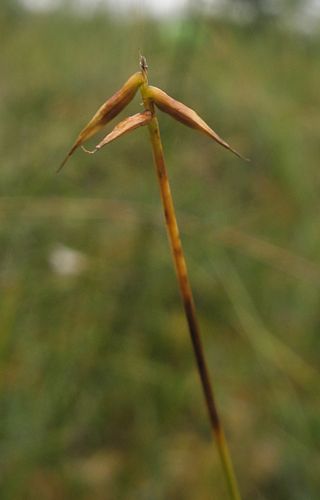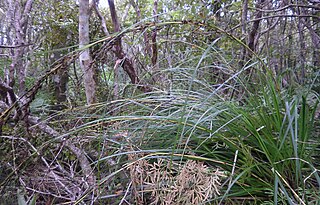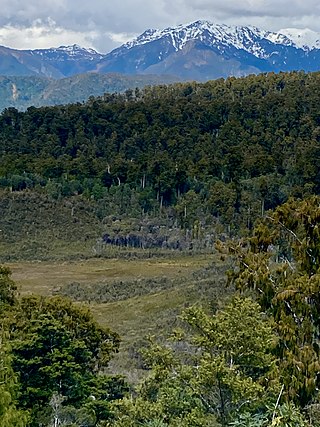
Eucalyptus pauciflora, commonly known as snow gum, cabbage gum or white sally, is a species of tree or mallee that is native to eastern Australia. It has smooth bark, lance-shaped to elliptical leaves, flower buds in clusters of between seven and fifteen, white flowers and cup-shaped, conical or hemispherical fruit. It is widespread and locally common in woodland in cold sites above 700 m (2,300 ft) altitude.

The forest ringlet, also known as Helms' butterfly, is a rare butterfly of the family Nymphalidae endemic to New Zealand. It is the only species in the genus Dodonidia.

Percnodaimon merula, the black mountain ringlet, is a satyrid butterfly in the family Nymphalidae. It is currently the only recognised species in the monotypic genus Percnodaimon, endemic to New Zealand, although there may be other undescribed species in the genus. The black mountain ringlet is notable for living exclusively in rocky areas of New Zealand's Southern Alps, usually above 1200 m. Its eggs are laid on rocks, its larvae feed on mountain Poa species, and it pupates under a stone. It has distinctive dark velvety wings and a zig-zag flight pattern over the scree slopes on which it lives.

Carex pauciflora, known as few-flowered sedge, is a perennial species of sedge in the family Cyperaceae native to Holarctic wetlands. The specific epithet pauciflora, refers to the Latin term for 'few flowered'.

Gahnia is a genus of sedges native to China, Southeast Asia, New Guinea, Australia, New Zealand and a number of Pacific Islands. The common name is due to the toothed margins. It often forms tussocks.

Tussock grasses or bunch grasses are a group of grass species in the family Poaceae. They usually grow as singular plants in clumps, tufts, hummocks, or bunches, rather than forming a sod or lawn, in meadows, grasslands, and prairies. As perennial plants, most species live more than one season. Tussock grasses are often found as forage in pastures and ornamental grasses in gardens.

Thelymitra pauciflora, commonly called the slender sun orchid in Australia and maikaika or maika in New Zealand is a species of orchid in the family Orchidaceae. It is one of the most widespread and common orchid species in Australia, growing in all states except Western Australia and the Northern Territory, and also in New Zealand including Chatham Island.

Gahnia trifida, the coastal saw-sedge, is a tussock-forming perennial in the family Cyperaceae, endemic to southern Australia.

Gahnia aspera known as the rough saw-sedge or round sawsedge is a tussock forming perennial plant, often seen in moist situations. The long strap like leaves grow to 80 cm long.

Gahnia grandis is a tussock-forming perennial plant found in southeastern mainland Australia and Tasmania.

Gahnia sieberiana, commonly known as the red-fruit saw-sedge, is a tussock-forming perennial plant in the family Cyperaceae, endemic to Australia. It is a widespread plant that favours damp sunny sites. Many insect larvae have been recorded feeding on the red-fruit saw-sedge. It may grow over 2 metres tall.

Gahnia setifolia, commonly known as mapere, gahnia, giant gahnia, or razor sedge is a native sedge of New Zealand. It is found throughout the North Island and top of the South Island of New Zealand.
Gahnia radula, commonly known as the thatch saw-sedge is a tufted perennial sedge native to south-eastern Australia. The leaves are long, flat and rough, with sharp edges. It has a distinctive brown inflorescence, which darkens to black. It grows to 50–100 cm in height, spreads through its rhizomes and is found in eucalypt forest and grassy woodland.
Gahnia clarkei is a species of evergreen plant from a sedge family that can be found in Australia. The plant is 1.5–2 metres high, with the same width. They grow during summer and have large black to brownish flowers. The flowers contain heads that produce small red seeds.
Tabernaemontana pauciflora is a species of plant in the family Apocynaceae.
Kopsia pauciflora is a tree in the family Apocynaceae. The specific epithet pauciflora means "few-flowered".
Gahnia howeana is a flowering plant in the sedge family. The specific epithet refers to Lord Howe Island, where it is found. It was formerly lumped with Gahnia xanthocarpa, which is now considered to be endemic to New Zealand.

Valeriana pauciflora, commonly called the largeflower valerian, is a plant species in the Caprifoliaceae. It is native to the Eastern United States, where it is found in the regions of the Interior Low Plateau, the Ohio River drainage, and the Potomac River Valley. In this region, it is found in very nutrient-rich, mesic forest communities, often in stream valleys or lower slopes.

Machaerina juncea, commonly known as bare twig-rush or tussock swamp twig rush, is a sedge in the sedge family, Cyperaceae, that is native to Australia, New Zealand, and New Caledonia.

Pakihi or pākihi is a vegetation association unique to the West Coast of the South Island of New Zealand, characterised by flat boggy land with infertile, waterlogged soil on which only rushes, ferns, moss, and mānuka grow.















